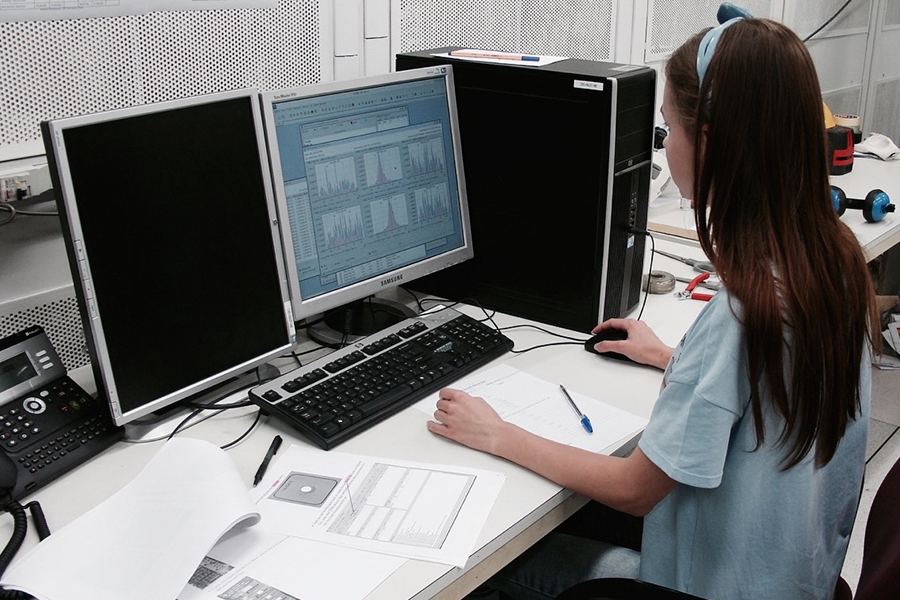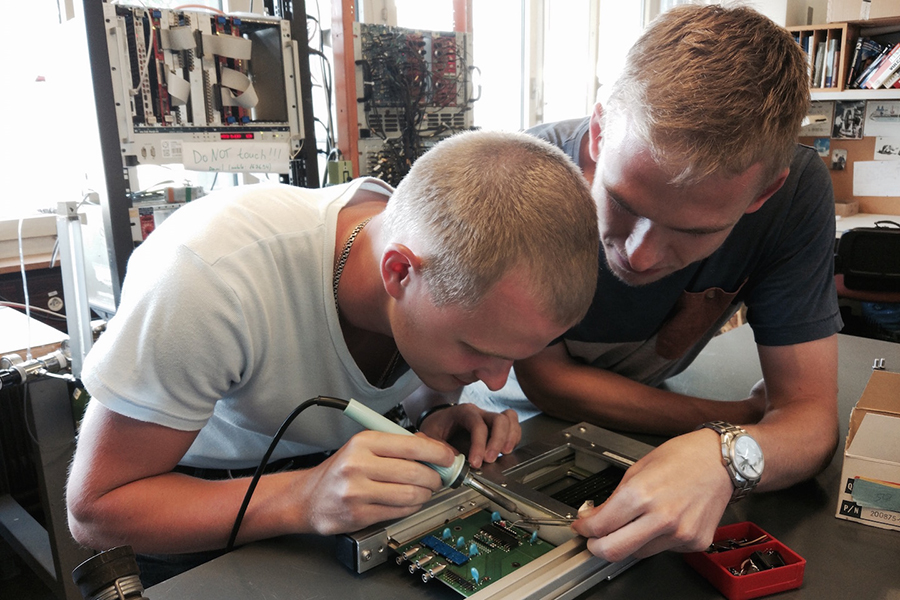This summer the ATLAS group of MEPhI is holding the next testing session of different prototypes of transition radiation detectors under the direction of Professor Anatoli Romaniouk.
On the eve of the new session or “testbeam”, we were able to talk with Anatoli Romaniouk, as well as with experienced employees and young students, who visited the European center for nuclear research (CERN) for the first time and worked independently with particle beams at the SPS accelerator.
Anatoli Romaniouk, leader of the project
– Please tell us about the goals of the project?
– We are developing detectors of transition radiation, which can be used to identify high-energy hadrons in experiments at the Large Hadron Collider at CERN, as well as experiments at future accelerators and in the study of cosmic rays. One of the research programs where the new prototype can be applied is an experiment with the Small Angle Spectrometer, SAS. This experiment is at the formation now. Its main task will be the study of hadron production in proton collisions, which is important in itself; however, it will be also of great importance for the physics of high energy cosmic rays, where there is a mysterious effect at energy about 1017. As a detector that is capable of splitting hadrons in the TeV energy region is a key element of SAS, the existence of this experiment critically depends on the results of our developments. A collaboration of another experiment – COMPASS, which already exists, is also interested in the project of our group.
This year we investigated prototypes based on thin-walled proportional chambers, silicon pixel detectors and silicon micro-strip detectors. A prototype based on thin-walled proportional chambers was reassembled by our employees with a much improved characteristics compared to the previous year. The modified geometry allows to see the studied effects over a wider angle. In addition, this prototype pays a lot of attention to fault tolerance of all nodes. Our group analyzed spectral and angular characteristics of transition radiation obtained by radiators of different types, which we have created.
Konstantin Vorobyov, testbeam coordinator
– Please tell what is testing of a detector on a beam and why do you conduct such experiments?
– In any physical study at LHC, it is important to effectively identify the elementary particles, in other words be able to separate, for example, electrons from pi-mesons. It is just the goal of our detector. During the tests, we set the prototype on the path of a beam of elementary particles. When particles pass through the detector in sensing elements, it causes a signal which determines the type of particles. It is important to note that for particle identification we use signal not of the particles but transition radiation photons. These photons are emitted by particles when they are passing through a special radiators fixed in front of the detector. The prototype is able to capture these photons and measure their energy. That's why it is called the transition radiation detector.
This session with a particle beam, as for the previous sessions, was prepared in advance; knowledge which was gained during the analysis of data collected the last year was very helpful.
– Did you also coordinate the work of the whole team last year? What does it feel like to set up an experiment?
– In truth you have to spend a lot of time for the coordination of work between our team and the people who also work on the particle beam. “Accelerating time” is very valuable, there are several experiments conducted at the same time, so all researchers should be in touch with each other. It’s needed to agree the time and place where a prototype will be installed in advance, as well as the parameters of a particles beam with which we will work. Also you need to put tasks in front of each participant in your own group, to ensure that the task is clear and there won’t be any problems with its implementation. Tasks within the group are different. Someone is responsible for the assembly of detectors, one – for the creation of a system that will allow real-time supervision of data collection and status of each element of a prototype.

From left to right: Konstantin Vorobiev, Dimitri Krasnopevtsev, Petr Teterin next to the prototype of the transition radiation detector
Petr Teterin, one of the prototype creators
– As we know, this year you have been engaged in the creation of the prototype. Is it difficult to create a particle detector?
– It is not an easy task to create a high-quality detector of elementary particles, even in our case where there is a well-thought-out plan and an example of a successfully working Transition Radiation Tracker. I gave an example, because our prototype is based on the same basic components. From my point of view this year our group has a good financial support. This allowed to make a prototype of a higher quality.
Physical data analysis of the last year has showed the extent of results’ contrariety. This year we should eliminate systematic errors of the experiment associated with "hardware". This time we are very careful in the selection of materials for the prototype. We test different plastics and compositions for bonding of parts. It is important that they provide the necessary electrical and gas isolation.
– Does the whole group consist only of MEPhI representatives?
– As for the prototype of the transition radiation detector, then it really involves experts mainly from MEPhI and also a few people from MSU and LPI. However this year we have closely worked with groups from Italy and Switzerland. Foreign colleagues tested their prototypes with us. The work of several different detectors with the same beam is very useful. If there are difficulties with the interpretation of the data from one detector, you can always see what the other has fixed. In experimental physics there is a principle that only those results can be considered as valid that were received at least by two independent experiments. That’s why work with several different detectors operating with the single beam is important because they can confirm the results of each other.

Diana Pyatiizbyantseva is conducting a collimation of a beam of particles on a duty during the collection of statistics
Diana Pyatiizbyantseva, master degree student of the MEPhI Department №40
– Please tell about your participation in testbeam.
– This summer I was fortunate to undertake an internship at CERN along with several other students of MEPhI. We went specifically to take part in the testing of the prototype of the transition radiation detector.
Before we started we had had special trainings, during which we were told in details about all the features of the work. I remember around the clock duties or shifts during the data collection. Those shifts lasted eight hours, and sometimes more. During the shift I had to change the radiators, to change settings of a particle beam, to monitor the performance of each component, as well as the quality of the recorded data. As you can see, the scope of work was very large, that’s why we worked not alone but two or three people at once. Each such group necessarily had an experienced person who took part in a testbeam in the last year. I spent here three weeks which were filled with various tasks and regular meetings. I would like to express special thanks to MEPhI for the opportunity to visit such an interesting place and grow professionally.
Semyon Doronin, master degree student of the MEPhI Department №40
– Please tell how was your trip to CERN?
– I have joined the MEPhI group at ATLAS relatively recently, and in the very first year I have had such a wonderful opportunity to take part in a real experiment. From the very first days of work senior colleagues helped me, they treated me with respect, understanding and patience, despite the fact that sometimes I couldn't do something. We have always enjoyed the friendly and warm atmosphere. I want to thank all of them for the knowledge and skills that I have gained working with them.
Even before coming to CERN, I began to work with my supervisor on mathematical modeling which reproduces the physical processes in the prototype, so it was particularly interesting for me to see how it works live. During the testbeam I worked directly with the components of the detector. For me, as a person who plans to do with electronics, it was an irreplaceable experience. Processing of the received data begun just after the testing, in which I also participated. As it can be seen, the work was very diverse; received knowledge and skills may be useful for me in several areas of science in the future. I want to thank the leadership of MEPhI, as well as the head of the MEPhI group in ATLAS Anatoly Romaniuk for the opportunity to participate in the international experiment and gain new knowledge and experience.

From left to right: Semyon Doronin and Roman Radomski carry out soldering of a chip of one of the modules of the transition radiation detector
Roman Radomski, a master degree student of the MEPhI Department №40
– How did your trip to CERN help in your study at MEPhI?
– Currently I am engaged in the processing and analysis of data obtained during the last testbeam in the framework of my scientific research work in MEPhI. I have always been interested to know more about how the data were obtained, and also take part in the experiment.
When we arrived at CERN, the guys from our Department helped us to quickly make all documents, receive the necessary equipment (e.g. dosimeters) and to begin the internship. From the first day we were completely immersed in the work. By the way, the atmosphere was amazing there. You're always surrounded by experienced professionals, can always find someone to ask for advice or discuss something from your scientific work. All to whom I spoke were very attentive to my questions and tried to help. That's what I liked the most.
The work itself was diverse – we didn’t do the same job all the time. There were many tasks and time was limited, so we often had to be late from work. When the installation was ready for the collection of data, we had a small introductory course, so that we were able to work independently on a shift during a set of statistics. From that moment every day of the whole week we had meetings at the same time where we reported on the results of the day. Colleagues from other countries worked with us and it was a great opportunity to get new knowledge and to practice English. I would like to thank the leadership of MEPhI for such a unique opportunity to participate in the international experiment and get invaluable experience.

The working meeting of the group. From left to right: Francesco Loparco, Sergey Konovalov, Anatoli Romaniouk, Konstantin Filippov, Petr Teterin, Alexander Savchenko, Semyon Doronin, Roman Radomski, Diana Pyatiizbyantseva, Konstantin Vorobyov, Evgeniy Shulga, Daniil Ponomarenko, Vladimir Tikhomirov
The material was prepared by Ekaterina Oreshkina and Dimitri Krasnopevtsev





